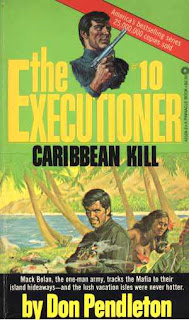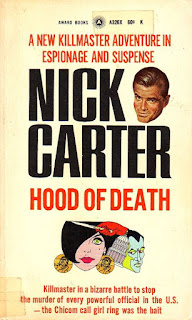Depth Force #6: Sea Of Flames, by Irving Greenfield
June, 1986 Zebra Books
The Periscope Turns as Irving Greenfield delivers another soapy installment of Depth Force, per series template picking up immediately after the previous volume. And as ever you’re just S.O.L. if you haven’t read that one, because Greenfield throws the reader right in with little backstory or setup. But also per series template this part is quickly wrapped up, with the majority of Sea Of Flames more so about the melodramatic lives of its many characters…before the plot promised on the back cover kicks in for the final quarter.
But having read that previous volume I was at least prepared for this cold open – Captain Jack Boxer had commanded an experimental sea/land vessel called the Turtle into Libya, where he was to drop an assault party which was expected to endure mass casualties in a pitched battle against Muslim extremists. The novel ended with Boxer learning pretty much everyone was dead but Boxer’s pal Vargas, the CIA spook, and Boxer decided to send the Turtle in to save him. Thus Sea Of Flames opens with an action scene – a quite boring action scene, mostly relayed, again per series template, via dialog, as Boxer shouts out orders on the Turtle’s bridge and info is relayed back to him. This series certainly lacks the typical immediacy of the genre.
Boxer manages to extract Vargas and another of the landing party, a fellow spook named Morell who turns out to be the bastard who set up the landing party. Later we’ll be given vague reasons for this sellout by chief spook Kincade, Boxer’s archenemy and boss – not to mention grandfather of Boxer’s latest bedmate Trish, who made her debut in #4: Battle Stations. The Morell subplot seems to promise things (none of which pan out in this installment, naturally), with him trading intel on how the Turtle can avoid hidden mines in exchange for safe passage off the ship. Last we see of him he jumps off a boat on the way to Sicily, evading Boxer’s orders for his death; Kincade later claims that Morell was following orders, or something, and also that he has Mob connections, so Boxer better watch out if he ever tracks him down to mete out revenge.
The Turtle gets destroyed anyway; this after Boxer has sent it back into the depths and has been busy dealing with Captain Bush, the psychopath who went nuts on the bridge and tried to rape Cynthia Downs, another of Boxer’s many previous conquests. Bush pleads to be returned to command and Boxer grapples with whether he should be kept locked up or not(?!). The Turtle is attacked or something – I kind of lost the thread at this point – and Boxer has to abandon ship. He’s the last off, along with an injured Vargas, and the CIA agent dies on the way to the surface. Boxer mourns him for a couple pages – so distraught in fact that he turns down an offer for sex from Vargas’s sister, after the funeral in New York!
Boxer actually turns down a bit of sex in this one; on the flight from Italy to New York, he finds himself sitting beside a hot redhead lawyer, Francine, who apparently debuted in the previous volume…as we’ll recall, in one of the arbitrary subplots Depth Force is known for, Boxer was contacted to handle the estate of a dead pal, in particular ensuring that the dead pal’s son got this and that. Well, Francine was the lawyer working the estate, I guess – I have to admit I’ve forgotten – and the two chat away on the flight, with it all clearly leading to another of Greenfield’s sex scenes. But Boxer, despite his interest in the lady, never goes through with it, even when later in the novel he enjoys a homecooked meal at Francine’s place. This is mostly because Boxer has fallen in love with Trish and plans to ask her to marry him.
But before all that – As The Periscope Turns! Folks I kid you not, the captain comes on the plane’s PA and announces that he’s just been informed there’s a bomb onboard(!). And mind you this is a commercial flight, Boxer and his remaining crew getting a ride on it for hazy reasons. We’re vaguely informed that the Libyans Boxer was fighting at the start of the book planted the bomb in revenge, somehow knowing Boxer et al were onboard…whatever. It gets super-goofy as Boxer goes into the cockpit and helps out, but meanwhile a Libyan fighter plane is dogging them and ends up shooting the plane out of the sky. This entire sequence is written in the lifeless prose of the series: “The plane crashed down into the water and quickly began to settle.” That’s how the plane crash is written, folks – no immediacy, no impact.
Boxer also turns down the promise of sex courtesy his ex-wife, Gwen, a soap opera star (how telling, given the bent of this series). Did any of you know that Boxer has a prepubescent son? I sure as hell didn’t, but maybe we were informed back in the first volume, which I don’t have – and as we know, you only get one chance with Irving Greenfield. The dude isn’t one for reminding his readers of anything from previous books. Well anyway this arbitrary plot is almost hilarious in how half-assed it is; Boxer in that plane crash realized he hadn’t seen his son in two years(!) and vowed to visit him. The boy, John, is “seven or eight,” per Boxer, who truly doesn’t remember. All this is relayed to “Chuck,” this rebel-type young man Boxer abruptly meets up with in Staten Island…no setup or anything, naturally, but apparently this guy was the son of “Rugger,” one of Boxer’s many dead friends. Perhaps it’s the same kid who came into that inheritance brokered by Francine in the previous book. Folks I really don’t the hell know at this point.
Well anyway, all this stuff with Chuck is just goofy as can be; Boxer runs afoul of the rough types in the neighborhood, and to prove he’s a big man in the Navy he radios in a “Code Ten.” This brings in a squad of marines who close down the street, with helicopters flying around. Seeing he’s proved his point to the dumbass locals, Boxer tells the marines “all clear,” and they leave. They just leave! And later Boxer chuckles about the situation with his commander! But anyway by the time we finally get to John, aka Boxer’s “seven or eight” year-old son, Greenfield has become bored with the whole thing and gives the kid like two lines (“Daddy! I missed you!”), and ends the scene – apparently Boxer’s plan is to have Chuck hang out with John; Boxer himself clearly has no plans to. And yet the next day as he’s flying home to DC, looking forward to screwing Trish silly, Boxer “feels good about himself.”
Boxer’s devotion to Trish is ironic given that she’s in the midst of a hot and heavy affair with Borodine, aka Boxer’s Russian archenemy/best friend. Trish doesn’t come off particularly well this time, wantonly screwing Borodine (for once, mostly off-page) and openly lying to Boxer, sometimes savoring to herself the fact that she’s just had sex with two dudes within hours of each other. While she keeps the affair secret from Boxer, Borodine is aware of it. I mentioned back in my review of the third volume that, when I discovered a few volumes of Depth Force on the shelf of a used bookstore some years ago, I opened one of them up right on a random hardcore sex scene, as arbitrary as could be. Well, this book was the one – Trish graphically fondling herself as she imagines being double-teamed by Boxer and Borodine and screaming as she climaxes, “They’ll never do it! They’ll never fuck me together!” We also get a few XXX bits with Boxer and Trish, but none of it’s as explict as prevoius volumes – at least, the word “bung hole” doesn’t appear this time around.
But while the series is soapy, one must never forget how cruelly its characters are treated, in particular the female characters. While we know from the scenes in her perspective that Trish has guessed Boxer is going to propose to her – but plans to tell him no – it’s still a bit of a shock when, during dinner with Boxer and Borodine (Trish again relishing that she’s sitting down with both her conquests, and also relishing Boxer’s ignorance of this fact), Trish’s ex-husband walks in and shoots Trish in the head! We’re soon informed she’ll “never wake up,” in other words she’s now a vegetable. But by novel’s end Greenfield has decided to hell with this and has Kincade radioing Boxer (in the middle of a battle!) and informing him that Trish has died(!). Meanwhile Boxer’s already decided to move on…it’s really humorous in a way, friends. Occasoinally he’ll think about her, but within pages he’s like, “I’ll be okay.”
Trish’s ex-husband by the way is our segue into the plot promised on the back cover; his name is William McEllroy (he also first appeared in the fourth volume) and he’s a “former congressman” who now leads a sort of hard-right army dedicated to starting war with Russia (still communist in Greenfield’s fictional 1997). This group, which brings to mind the rebel government in Greenfield’s earlier Waters Of Death, plans to take over the world in the wake of a nuclear holocaust. They’re a pretty resourceful bunch, managing to free psychopath Captain Bush from the funny farm (where Bush kills a couple people “accidentally”) so that he can captain the Shark, ie the top secret nuclear sub normally commanded by Boxer. They even manage to steal the Shark, leading us into the “tense” climax.
Almost immediately after Trish’s assault – McEllroy humorously escaping without much fuss – Boxer is informed the Shark has been stolen. He’s put in charge of another vessel, the Neptune, and gives chase before the Shark can launch nukes on Moscow, thus ushering in WWIII. Russia is alerted, and none other than Borodine commands his own nuclear sub as both countries join to find and stop the Shark. Once again it’s all relayed via dialog; there are more scenes of Boxer and his chief mate Cowly “sipping coffee” on the bridge than the sort of bloody violence you’d expect from a book labelled as “men’s adventure” on its spine.
As expected, Captain Bush goes nuts, killing off everyone but McEllroy, then taking off to incredible depths and changing route, his plan to nuke Paris and other European countries instead of Russia. The two men get in a fight and McEllroy knocks out Bush, but he can’t pilot the Shark and they’re further beneath the sea than any other vessel can go, so McEllroy is kind of screwed. At any rate this is where Sea Of Flames ends, but we can predict how the next one will go down: quick wrapup of this plot in the opening pages, followed by some long-simmer soap.







